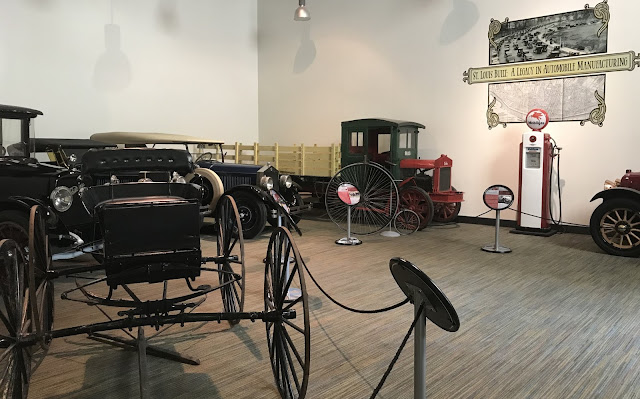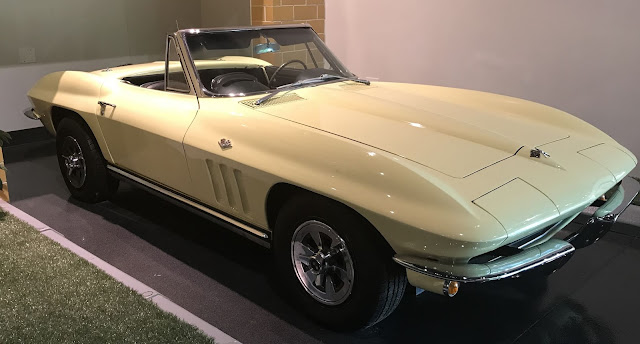St. Louis 63122
314-965-6212
Admission is $10.00 adults and $5 children. Parking is free.
http://transportmuseumassociation.org/
Opened in 1944
This continually growing museum sits on 129 acres formerly owned by the Missouri Pacific Railroad. It includes nine
museum exhibit areas, both inside and outside. There are two entrances by car and we chose to enter #2 which put us in the center of most of the exhibits.
Our first stop was Barrett Station where we received our admission wristbands and saw some railroad exhibits.
Several display cabinets contained train mementos, such as these dining dishes, railroad fireman's caps and goggles, and various railroad lanterns.
And of course there was a model train on display.
From Barrett's Station one can join a tour of the train exhibit. The tours are offered at 10:00 a.m. and 1:00 p.m. We were fortunate to have a private tour by one of the museum volunteer restorers. The Train Yard houses a good portion of their railroad collection.
The museum has more than 70 locomotives and many are here in the Train Yard. This 1952 experimental gas-turbine locomotive was built for the United States Army.
Below is the sole-surviving gear-less "bi-polar" locomotive. It was built in 1920 to pull transcontinental passenger trains through the Cascade Mountains.
This locomotive was built in 1906 and was used to transport passengers from Grand Central Station in New York City to trains outside the city. It ran on electrified track and therefore cut way down on the smoke pollution in the NYC train tunnels.
Built in 1935, this locomotive was the first non-articulated, high speed, mainline passenger locomotive on the American railroads.
Built in 1939, the "Silver Charger" weighed 202,000 pounds and was the last of the early "Zephyr" trains in which the car body housed the engine and doubled as a mail/baggage car.
This rotary snowplow was built in 1966 by Union Pacific and is the heaviest ever built at 367,400 pounds. It was pushed forward by 3 or 4 locomotives and threw snow on both sides of the tracks.
The Union Pacific "Big Boy" was the largest successful steam locomotive ever built, with a total weight of over 600 tons. Only 25 were built. It could pull trains up to 5.5 miles long.
A handful of trains cars in the Yard are open to visitors including the cab of the "Big Boy." Inside you can see this auger, or Stoker Screw, that carried the coal into the firebox.
One can also sit in the cab, marvel at all of the valves, and enjoy "driving the train!"
Along with the locomotives in the Train Yard are other train cars, such as these two cabooses, a railway car no longer in use.
Below is the world's largest tank car. At over 96 feet it is too long to pass today's restrictions. It was called the "whale" and carried 60,2000 gallons.
When functioning, visitors can work this light signal.
Fortunately a number of trains are housed in Robert's Pavilion where the elements do not effect restored train cars such as this 1858 wood-burning American locomotive, the Daniel Nason. It is the oldest locomotive at the museum. It is also the only surviving example of "Dutch Wagon" practice where the steam cylinders are inside the locomotive frame, a design popular prior to the Civil War.
This Black Diamond locomotive built in 1889 in Pennsylvania is believed to be the last steam inspection locomotive in existence today. It has a walnut paneled observation room that seats eight.
This 1939 Illinois Terminal Railbus was originally built as a school bus and then adapted for rails. It was used to transport passengers from Grafton to Alton.
The museum has displayed the interior of this Missouri Pacific passenger train, similar to the one that Truman rode many times during his U.S. presidency, so that visitors can see through windows into the inside of the various cars, such as this sleeper.
This parlor-observation car seated many.
This is an office car.
And then, of course, the dining car.
This is one of several luggage carriers on display by this train.
Four days a week there are free trolley rides on the Streetcar Loop in front of this pavilion.
These locomotives and coal car below have been recently refurbished by museum volunteers and sit by the trolley tracks. The museum hopes to be able to build more pavilions to house all of the trains thus preserving the refurbishing work which has already been done and making future projects worthwhile. Next to these rail cars is the Abbott Building that houses the historic trolleys and the Katy Flyer.
This is one of two tunnels built by the Missouri Pacific in this location between 1851 and 1853, making them the first railroad tunnels west of the Mississippi River. They were in use until 1944. Currently they are used for storage!
We next visited the Earl C. Lindburg Automobile Center which opened in 2006.
This automobile was built in 1901 by the St. Louis Motor Carriage Company, the first successful automobile business west of the Mississippi River.
This A. L. Dyke steam-power car was sold in a kit form 1901-1904 by this St. Louis company. It was discovered unassembled in the late 1950's and then put together and driven for many years.
Cool bicycle!
The St. Louis-based Moon Motor Car Company built the roadster on the right in 1924.
The main room of this center is filled with various cars.
This Ford Model N was built it Indiana in 1906 and sold for around $500.
This Hupmobile, Model 20 Runabout, was built in 1910 in Detroit. Horse-drawn Milk Wagons remained well after the advent of the automobile. This one, built in St. Louis in the 1920's, was not retired until 1950.
This 1941 Cadillac has its doors open allowing visitors to see the interior.
This Studebaker Commander Starlight Coupe was built in 1951. It was so innovative that it actually had child-proof rear door locks as an option.
This 1957 Chevrolet Bel Air Convertible, built in St. Louis, is displayed in a era-appropriate exhibit!

This Detroit-built DiDia was built in 1960 and the cost in today's dollars was close to 1.5 million. Ground diamonds were used in the original paint on this car. This particular vehicle was owned, driven, and then donated by singer and actor Bobby Darin.
No car museum is complete without a Chevrolet Corvette. This 1965 model was built in St. Louis and cost new $3212.
This Center has a few display cases. On an upper balcony you will find many many different speedometers used in cars.
St. Louis area Coral Court Motel was known for, among other things, its secrecy in that you could pull your car into a garage and no one would know that you were there! So of course, when the motel was taken down a garage was donated to the museum.
The large Orthwein Center sits on the lower side of the museum by Entrance #1 and opened in 2012. Unfortunately it is an uphill or downhill hike between this building and the rest of the museum buildings and displays. We drove it!
When one enters the building one can pull the steam whistle!
Inside are some wonderful refurbished vehicles including this 1833 Boston & Providence Stagecoach which is the oldest original railway passenger coach know to exist in America. It was originally pulled by horses and then later steam locomotives.
This Storm Buggy or Cozy Coach dates from the mid-1800's in Seymour, Indiana; and is one of only two known to exist still.
This 1870's Railway Mule Car was pulled by mules between downtown and Bellefontaine in north St. Louis County until 1895. The car had no heater. In winter, the company spent three cents a day for straw to cover the floor to add warmth for riders.
This 1910 Buick Motor Bus held 12 passengers and typically was used by hotels. It is believed that this "Old English Motor Bus" is one of the only surviving models of this type. This 1929 street sweeper was the first one designed to clean streets used by automobiles as opposed to horse-drawn traffic. It is believed that this is the oldest street sweeper in America.
This produce peddler's truck is a combination of a 1937 Chevrolet truck chassis an a 1920s era custom built wood coach. It was used to sell groceries here in St. Louis until the 1950s.
The Orthwein Center has a few wall displays including this time line.
This one is dedicated to child's train travel in the 1940s.
This one is dedicated to the mutt Owney, the unofficial mascot of the Railway Mail Service in the late 1800's. He traveled more than 140,000 miles by rail around the USA with the Postal Department.
In this building is an area dedicated to teaching young children about traveling. For $2 they can be admitted to the Creation Station.
There are also outside activities right outside the door for young children. Two children can sit in this handcar train and power it around the tracks and through the tunnel.
For $5 one can ride the miniature train which goes quite a ways around the lower end of the park.
There are also educational signs in the children's area outside.
The grounds also house a few other modes of transportation including this H. T. Pott Towboat and C-47A Transport Plane, which visitors are allowed to explore.
There are three gift shops on the grounds. There is a small one in Barrett Station Depot.
The Orthwein Center has two gift shops including this one that has a cafe.
The second gift shop is full of lots of fun items.
After we left the museum we drove 1.5 miles to The Corner Pub & Grill. This local restaurant has a second location in Chesterfield.
Their special was fish tacos and their vegetable of the day was Brussels sprouts.
Steak Salad
Pretzel Bacon Cheeseburger with WONDERFUL chips
Corner Royale Burger with fries
It is very impressive how many trains cars and automobiles that the museum owns are one-of-a-kind still in existence. No wonder the Smithsonian Institution recognizes the museum as having "one of the oldest and best collections of transportation vehicles in the world."
We were privileged to be taken on a private tour by a friend of one in our group. I definitely think it is worth going on a guided tour; they are offered twice a day. You learn such fun facts. The signs by each of the vehicles are very informative and are worth taking time to read if not on a tour. There were also friendly docents in each of the buildings.
This museum is so big and spread out that I can't imagine it being a problem to go on a day that there are field trips there visiting. We went on a summer Monday morning and there were a number of visitors but there was never a situation where we felt crowded.
The biggest complaint I hear about this museum is that in the summer it can be very hot going through the outside train yard as there is little shade. This is also true if you chose to park by the Orthwein Center and walk up the large hill to the displays. I am very glad that we drove from one section to the other.
We all enjoyed our lunch at The Corner Pub & Grill at 13645 Big Bend Road. They offer a very large gluten-free menu. Their chips are OUTSTANDING!















































































No comments:
Post a Comment